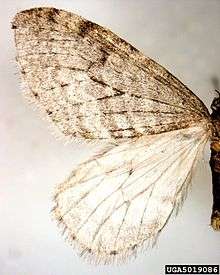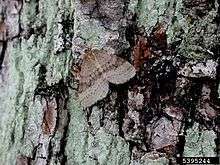Operophtera bruceata
Operophtera bruceata, the bruce spanworm, hunter's moth, or native winter moth is a species of moth of the family Geometridae. It is found from coast to coast in southern Canada and the northern parts of the United States.[1]
| Operophtera bruceata | |
|---|---|
 | |
| Adult male | |
 | |
| Adult male | |
| Scientific classification | |
| Kingdom: | |
| Phylum: | |
| Class: | |
| Order: | |
| Family: | |
| Genus: | |
| Species: | O. bruceata |
| Binomial name | |
| Operophtera bruceata (Hulst, 1886) | |
| Synonyms | |
| |
The wingspan of the males is 25–30 mm. Females have underdeveloped wings and do not fly. Adults are on wing from October to December.
Bruce spanworm looks very similar and has a similar life cycle to the invasive congener winter moth (O. brumata). Bruce spanworm is known to hybridize with winter moth.[2] The two species look almost identical to one another; however, they can be distinguished morphologically by comparing uncus shape or by using DNA analyses.[3] Bruce spanworm uses the same pheromone as winter moth.[4]
The larvae hatch in the early spring after overwintering as eggs. The neonates primarily feed on the buds and nearly unfurled leaves of sugar maple, American beech and trembling aspen. They have also been recorded on willow and various other deciduous trees. After feeding for a few weeks, the late instar caterpillars drop down to the soil and build an earthen cocoon. The pupate until the late fall or early winter when they emerge as adults.
Disease from viruses and microsporidia have been noted to effect the larvae and pupae of Bruce spanworm. Virus infections by a nucleopolyhedrovirus (NPV) baculovirus was found to be low in Bruce spanworm populations collected in the northeast U.S. and was found to be related to but distinct from the NPV that was detected in winter moth in the same region.[5] However, collections for Bruce spanworm larvae from an outbreak population in Maine had high levels of infection by microsporidia.[6]
Gallery
 Egg
Egg Egg
Egg Larva
Larva Feeding signs
Feeding signs Adult female
Adult female Adult female
Adult female
References
- Gwiazdowski, R; Elkinton, J; Dewaard, J; Sremac, M (2013). "Phylogeographic Diversity of the Winter Moths Operophtera brumata and O. bruceata (Lepidoptera: Geometridae) in Europe and North America". Annals of the Entomological Society of America. 106 (2): 143–151. doi:10.1603/AN12033.
- Havill, N; Elkinton, J; Andersen, J; Hagen, S; Broadley, H; Boettner, G; Caccone, A (2017). "Asymmetric hybridization between non-native winter moth, Operophtera brumata (Lepidoptera: Geometridae), and native Bruce spanworm, Operophtera bruceata, in the Northeastern United States, assessed with novel microsatellites and SNPs". Bull Entomol Res. 107 (2): 241–250. doi:10.1017/S0007485316000857. PMID 27876095.
- Elkinton, J; Boettner, G; Sremac, M; Gwiazdowski, R; Hunkins, R; Callahan, J; Scheufele, S; Donahue, C; Porter, A; Khrimian, A; Whited, B; Campbell, N (2010). "Survey for Winter Moth (Lepidoptera: Geometridae) in Northeastern North America with Pheromone-Baited Traps and Hybridization with the Native Bruce Spanworm (Lepidoptera: Geometridae)". Annals of the Entomological Society of America. 103 (2): 135–145. doi:10.1603/AN09118.
- Elkinton, J; Lance, D; Boettner, G; Khrimian, A; Leva, N (2011). "Evaluation of pheromone-baited traps for winter moth and Bruce spanworm (Lepidoptera: Geometridae)". J Econ Entomol. 104 (2): 494–500. doi:10.1603/EC09322. PMID 21510197.
- Broadley, H; Boucher, M; Burand, J; Elkinton, J (2017). "The phylogenetic relationship and cross-infection of nucleopolyhedroviruses between the invasive winter moth (Operophtera brumata) and its native congener, Bruce spanworm (O. bruceata)". Journal of Invertebrate Pathology. 143: 61–68. doi:10.1016/j.jip.2016.11.016. PMID 27916614.
- Donahue, K; Broadley, H; Elkinton, J; Burand, J; Huang, WF; Andersen, J (2018). "Using the SSU, ITS, and Ribosomal DNA Operon Arrangement to Characterize Two Microsporidia Infecting Bruce Spanworm, Operophtera bruceata (Lepidoptera: Geometridae)". Journal of Eukaryotic Microbiology. 66 (3): 424–434. doi:10.1111/jeu.12685. PMID 30136341.